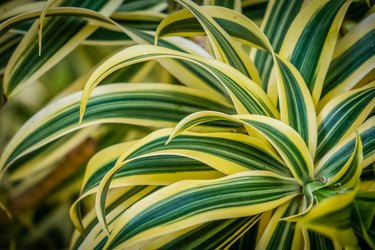
Houseplants add warmth and greenery to a space, and some even help to filter and clean the air in your home. If you have a large space to fill or simply have a flair for the dramatic, growing an indoor tree is an excellent way to bring the great outdoors inside. You'll have to pick your plants carefully, though, since some trees need more light than an indoor space can provide.
The Alii Ficus
Video of the Day
If you're looking for a tropical feel, the Alii ficus (Ficus maclellandii 'Alii,' USDA zones 9-11) may be the tree for you. This particular ficus has long, shaggy leaves that resemble palm fronds. These leaves are attractive and very good at staying on the plant, so you won't have a mess of dropped leaves under and around your ficus. It's important to note that the Alii ficus is attractive but poisonous when ingested, making it a poor choice around pets and small children.
Video of the Day
The Alii ficus tolerates a wide variety of lighting conditions, including low light. Because it accepts such a wide array of light levels, you can easily move your ficus if you rearrange your furniture. This plant generally tops out at 6 to 10 feet and needs water only when the top inch of soil is dry.
The Corn Plant
The corn plant (Dracaena fragrans, zones 10-11) gets its name from its long leaves, which do resemble the leaves of edible corn plants. This plant's leaves are a much brighter green, however, and have an attractive cream-colored stripe running down the middle. Left to their own devices, corn plants reach heights of 6 to 10 feet. If yours gets taller than you would like, simply trim the top to maintain the desired height.
Corn plants do well in low light but don't tolerate drafts well. They need to be watered when their soil is dry to the touch. In the spring and summer, you can give your plant a little liquid fertilizer every two or three weeks. If the plant's leaves turn yellow, the plant is getting too much water or too much fertilizer.
The Norfolk Island Pine
Sweeping evergreen boughs make the Norfolk Island pine (Araucaria heterophylla, zones 9-11) a stunning house tree. This charming tree isn't technically a pine at all but a tropical plant that hates the cold. It does very closely resemble a pine tree, however, and is often seen decorated during the holiday season. A potted Norfolk Island pine tree grows slowly, ultimately reaching a height of around 6 to 8 feet.
Norfolk Island pines prefer indirect light to sunny windows. They also like humidity, so mist yours once a week to keep it happy. Like many other plants, the Norfolk Island pine needs water only when the top of the soil is dry. If desired, you can provide a bit of water-soluble fertilizer in the spring and summer.
The Madagascar Dragon Tree
If you like low-maintenance plants, consider the Madagascar dragon tree (Dracaena marginata, zones 10-12). These trees produce spiky green leaves that are often edged in red. When grown in low light, the leaf tips may remain green rather than turning red, but the plant will do just fine. These trees can reach 12 feet in height but grow quite slowly indoors, usually reaching only 4 to 6 feet.
Even without red-margined leaves, the Madagascar dragon tree adds visual interest to a space thanks to its trunk. You can find these plants with a single trunk or in double- and triple-braid configurations. You can also grow several individual plants in one pot, creating your own little grove.
You'll find that your dragon tree easy to get along with. It likes its soil kept moist but demands little else. It tolerates being root bound if you don't get around to repotting as often as you should, and it doesn't really need to be fertilized very often. You can give the plant a light application of fertilizer in early spring if you like, but the tree won't complain if it doesn't get a meal.
Indoor Low-Light Tree Tips
When choosing a tree to plant indoors, always choose species that do well in low light and that don't require a lot of head room. Take toxicity into account as well since not all trees are safe for children and pets. Avoid litterbugs too. Trees that drop flower petals, leaves and seed pods can make quite a mess indoors.
Always pick plants that can thrive in containers, and water them with warm water since many houseplants are tropical. Remember to look for pest-resistant selections even though your plant will live indoors, Mites, whiteflies and other small insects can find their way inside and damage indoor plants.